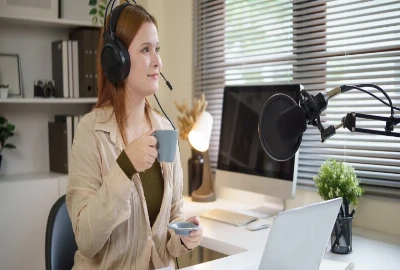Swipe to Heal: The Evolution of Wellness in the Age of Scroll Culture

We live in an era where wellness is only a swipe away. Meditation apps, motivational reels, and pastel-hued affirmations fill our feeds. From TikTok’s “hot girl walks” to Instagram’s breathwork tutorials, digital wellness culture has woven itself into our daily scrolling habits. But as self-care becomes increasingly mediated through screens, a paradox emerges: are we truly healing—or just performing wellness online?
The wellness industry has always evolved with technology. What began as yoga classes and self-help books has morphed into a multibillion-dollar ecosystem of apps, influencers, and algorithms promising calm in the chaos. Yet, in the age of endless scrolling, where dopamine hits are just a notification away, wellness itself risks becoming another form of consumption.
Still, the digital transformation of self-care isn’t entirely hollow. For many, these digital touchpoints serve as accessible entryways to mindfulness, therapy, and community. The rise of online wellness reflects a deeper generational need for connection and healing amid the overstimulation of modern life.
In this post, we’ll explore how wellness has evolved in the digital age—how scroll culture reshaped our relationship with healing, and what it means to find balance when the very device that stresses us out also promises to soothe us.
From Yoga Studios to Your Screen: The Rise of Digital Wellness Culture

The Accessibility Revolution
The first wave of digital wellness democratized self-care. Apps like Headspace, Calm, and Insight Timer brought guided meditation and mindfulness to anyone with a smartphone. Online fitness classes, therapy platforms, and nutrition trackers made holistic health accessible beyond gyms and clinics. What used to be niche or expensive suddenly became global and affordable—wellness for the Wi-Fi generation.
Influencers as Wellness Gurus
Social media introduced a new kind of wellness leader: the influencer-healer hybrid. Figures like Jay Shetty, Mel Robbins, and countless micro-influencers blend personal storytelling with professional advice. These creators make wellness feel relatable—sharing raw emotions, daily routines, and self-care checklists. But as wellness became an aesthetic, critics argue that its authenticity was diluted by commercialization. Self-care, once personal, turned performative.
The Pandemic Acceleration
The COVID-19 pandemic supercharged this digital shift. With physical spaces closed, people turned to screens for therapy, yoga, and even sound baths. Virtual wellness communities blossomed, offering comfort during isolation. The line between mental health support and digital engagement blurred, and suddenly, our phones were both the problem and the solution.
Scroll Culture and the Commodification of Self-Care

The Aestheticization of Healing
On Instagram and TikTok, wellness has been rebranded as a lifestyle—complete with calming color palettes, matcha lattes, and self-love mantras. This aesthetic has made wellness visually marketable, turning healing into content. The result is what some call performative self-care, where wellness becomes less about emotional depth and more about curating a brand.
Wellness as Consumer Culture
Scroll culture thrives on instant gratification, and wellness has adapted accordingly. Quick-fix affirmations, 30-second therapy clips, and detox teas all cater to short attention spans. The commercialization of self-care feeds the very anxiety it claims to relieve. Instead of helping users disconnect, much of online wellness keeps them scrolling—blurring the boundary between healing and hustling.
The Paradox of the Calm Feed
There’s an irony to seeking peace through platforms designed to keep us overstimulated. Algorithms reward engagement, not rest. Even wellness influencers are caught in a cycle of burnout, pressured to constantly produce content about slowing down. The “calm feed” becomes a contradiction: soothing visuals that still demand constant attention.
How Technology Is Redefining Healing

AI Therapists and Virtual Companions
The rise of AI therapy apps like Wysa, Woebot, and Replika marks a new frontier in emotional technology. These tools use conversational algorithms to simulate empathy, offering daily check-ins, mindfulness prompts, and mood tracking. While not a replacement for human therapists, they provide scalable mental health support—particularly in regions where traditional therapy is inaccessible.
Biofeedback, Wearables, and Mindful Tech
Wellness tech has become increasingly data-driven. Devices like Oura Rings, Apple Watches, and Muse headbands track heart rate, sleep, and stress levels to promote data-informed mindfulness. For many, this quantification of well-being offers accountability and insight. However, it can also turn healing into a performance metric—reducing calmness to statistics and graphs.
Digital Detox Retreats and Tech-Free Healing Spaces
Interestingly, the tech-driven wellness boom has inspired its own backlash. A growing number of creators now advocate digital detoxing—stepping away from screens to reconnect with the body and environment. Offline retreats, “dopamine fasts,” and analog hobbies are becoming essential parts of self-care routines. Even as technology powers wellness, balance demands stepping outside it.
The Psychology of Scroll-Based Healing

The Dopamine Loop of Digital Wellness
Social media exploits the brain’s dopamine system, rewarding us with micro-hits of pleasure for every like, share, and scroll. Digital wellness content often uses the same mechanisms—calming visuals, affirmations, soothing audio—to keep users engaged. This creates a dopamine feedback loop, where users seek emotional regulation through constant consumption rather than reflection.
The Illusion of Connection
Online wellness communities create a sense of belonging, but this connection can be illusory. While sharing affirmations or therapy memes may feel supportive, it often lacks the depth of genuine emotional intimacy. For some, the online wellness space becomes an echo chamber—comforting but ultimately isolating. Real healing still requires vulnerability, presence, and human empathy beyond the screen.
Wellness Fatigue and the Pressure to Self-Optimize
Ironically, the digital wellness movement can lead to self-improvement fatigue. When every scroll reveals new routines, diets, and mindfulness hacks, users begin to feel they’re never doing enough. The wellness ideal becomes another form of pressure—a subtle message that rest, joy, and acceptance must always be “optimized.”
Rethinking Wellness in a Digital Age

From Consumption to Consciousness
The next evolution of digital wellness must move beyond consumption. True healing in the age of scroll culture means shifting from passive scrolling to conscious engagement. This might look like using social media intentionally—following creators who inspire balance, setting digital boundaries, or using wellness apps mindfully rather than habitually.
Hybrid Healing: Combining Online and Offline Practices
Wellness doesn’t have to reject technology; it just needs balance. Many practitioners now blend digital tools with real-world practices—using meditation apps alongside nature walks, or attending online therapy while maintaining offline community support. The healthiest model of modern wellness embraces both connection and disconnection.
The Future of Wellness: Human, Not Algorithmic
The ultimate goal of wellness is not productivity or aesthetics—it’s presence. As algorithms evolve to predict our needs, it’s crucial that we reclaim emotional agency. The future of wellness lies not in smarter apps, but in smarter awareness—using technology as a bridge to ourselves, not a barrier.



